
Segovia is a city in the autonomous community of Castile and León, Spain. It is the capital and most populated municipality of the Province of Segovia. Segovia is in the Inner Plateau, near the northern slopes of the Sistema Central range and on a bend of the Eresma river.
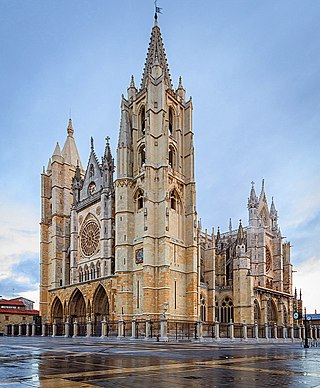
León is a city and municipality of Spain, capital of the province of León, part of the autonomous community of Castile and León, in the northwest of the Iberian Peninsula. It has a population of 124,303 (2019), by far the largest municipality in the province. The population of the metropolitan area, including the neighbouring San Andrés del Rabanedo and other smaller municipalities, accounts for around 200,000 inhabitants.

An alcázar, from Arabic al-Qasr, is a type of Islamic castle or palace in Spain built during Muslim rule between the 8th and 15th centuries. They functioned as homes and regional capitals for governmental figures throughout the Umayyad caliphate and later, for Christian rulers following the Iberian Reconquista. The term alcázar is also used for many medieval castles built by Christians on earlier Roman, Visigothic or Islamic fortifications and is frequently used as a synonym for castillo or castle. In Latin America there are also several colonial palaces called Alcázars.
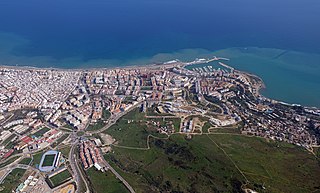
Estepona is a town and municipality in the comarca of the Costa del Sol, southern Spain. It is located in the province of Málaga, part of the autonomous community of Andalusia. Its district covers an area of 137 square kilometers in a fertile valley crossed by small streams and a mountainous areas dominated by the Sierra Bermeja, which reaches an elevation of 1,449 m at the peak of Los Reales.

Úbeda is a municipality of Spain located in the province of Jaén, Andalusia.

Tordesillas is a town and municipality in the province of Valladolid, Castile and León, central Spain. It is located 25 kilometres (16 mi) southwest of the provincial capital, Valladolid at an elevation of 704 metres (2,310 ft). The population was c. 8,760 as of 2021.

Juan de Herrera was a Spanish architect, mathematician and geometrician.

Miranda de Ebro is a city on the Ebro river in the province of Burgos in the autonomous community of Castile and León, Spain. It is located in the north-eastern part of the province, on the border with the province of Álava and the autonomous community of La Rioja. According to the 2008 census conducted by Spain's National Institute of Statistics, it has a population of 39,589 inhabitants, making it the second most populous city in the province after the capital, Burgos.
Guadamur is a municipality located in the province of Toledo, Castile-La Mancha, Spain. According to the 2008 census (INE), the municipality has a population of 1819 inhabitants.

The Royal Alcázar of Madrid was a fortress located at the site of today's Royal Palace of Madrid, Madrid, Spain. The structure was originally built in the second half of the ninth century by the Muslims, then extended and enlarged over the centuries, particularly after 1560. It was at this time that the fortress was converted into a royal palace, and Madrid became the capital of the Spanish Empire. Despite being a palace, the great building kept its original Arabic title of Alcázar.

Salamanca is a municipality and city in Spain, capital of the province of the same name, located in the autonomous community of Castile and León. It is located in the Campo Charro comarca, in the Meseta Norte, in the northwestern quadrant of the Iberian Peninsula. It has a population of 144,436 registered inhabitants. Its stable functional area reaches 203,999 citizens, which makes it the second most populated in the autonomous community, after Valladolid. Salamanca is known for its large number of remarkable Plateresque-style buildings.

The Palacio Arzobispal de Toledo or Archbishop's Palace of Toledo is a palace located in front of the Cathedral and next to the City Hall in the city of Toledo, region of Castile-La Mancha, Spain.
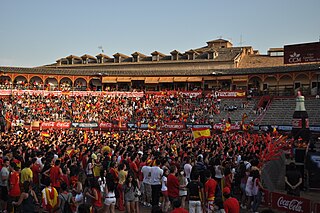
The bullring is a building located in Toledo, Castile-La Mancha, Spain.
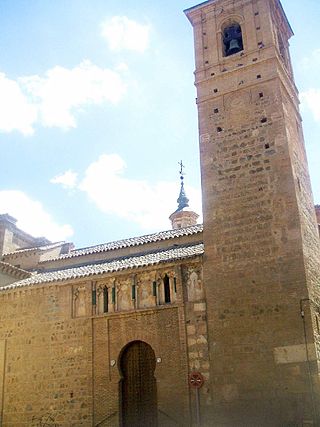
The Church of San Andrés is a Catholic church located in the city of Toledo, in Castile-La Mancha, Spain. The building is of medieval origin, and as is common in this city, is a mix of different styles. It is protected by the heritage listing Bien de Interés Cultural.
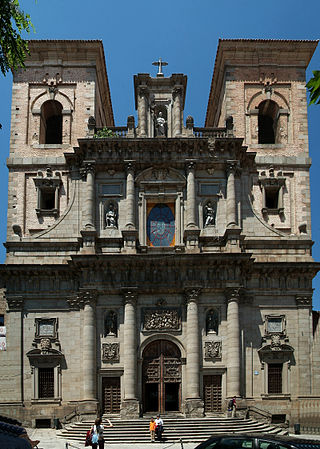
The Church of San Ildefonso is a Baroque style church located in the historic center of the city of Toledo, in Castile-La Mancha, Spain. It is also known as the Jesuit church and is consecrated to Saint Ildefonso of Toledo, patron of the city and Father of the Church.

The Church of St Leocadia is a medieval church located in Toledo, in Castile-La Mancha, Spain.

The Iglesia de la Magdalena is a church located in the city of Toledo, in Castile-La Mancha, Spain. Named after Mary Magdalene, it was founded by Mozarabs during Muslim rule.

The Palace of Fuensalida, is a palace located in city of Toledo built at the end of the first half of the 15th century by Pedro López de Ayala, the first lord of Fuensalida, is a great example of the Toledan Mudéjar, a historical typology that is scarce in Toledo built heritage, where merge three styles: Gothic, Plateresque and Mudéjar.
The Plaza de San Justo is a square located in the city of Toledo, in Castile-La Mancha, Spain. In the upper part of the city, halfway between the Alcázar and the Cathedral there is a square named after the Church of San Justo y Pastor. Of the same church and in that same square it says the legend of "The Christ of the Cutlery". There a sign where it read the legend where events are supposed to happen, or not.

The Plaza de las Cuatro Calles is a square located in the city of Toledo, in Castile-La Mancha, Spain. This square is the commercial heart of Toledo.





















